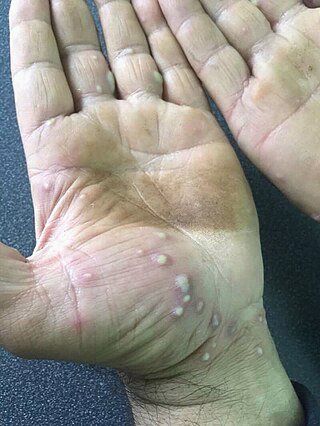
Nystatin, sold under the brand name Mycostatin among others, is an antifungal medication. It is used to treat Candida infections of the skin including diaper rash, thrush, esophageal candidiasis, and vaginal yeast infections. It may also be used to prevent candidiasis in those who are at high risk. Nystatin may be used by mouth, in the vagina, or applied to the skin.

Etoricoxib, sold under the brand name Arcoxia, is a selective COX-2 inhibitor developed and commercialized by Merck. It is approved in 63 countries worldwide as of 2007, except the United States where the Food and Drug Administration sent a Non Approvable Letter to Merck and required them to provide additional data.
SAPHO syndrome includes a variety of inflammatory bone disorders that may be associated with skin changes. These diseases share some clinical, radiologic, and pathologic characteristics.

Eczema herpeticum is a rare but severe and contagious disseminated infection that generally occurs at sites of skin damage produced by, for example, atopic dermatitis, burns, long-term usage of topical steroids or eczema. It is also known as Kaposi varicelliform eruption, Pustulosis varioliformis acute and Kaposi–Juliusberg dermatitis.

Pustulosis is highly inflammatory skin condition resulting in large fluid-filled blister-like areas - pustules. Pustulosis typically occurs on the palms of the hands and/or the soles of the feet. The skin of these areas peels and flakes (exfoliates). This condition—also referred to as "palmo-plantar pustulosis"—is a feature of pustular psoriasis.

Interleukin 36 receptor antagonist (IL-36RA) is a member of the interleukin-36 family of cytokines. It was previously named Interleukin-1 family member 5 (IL1F5).

In medicine, a drug eruption is an adverse drug reaction of the skin. Most drug-induced cutaneous reactions are mild and disappear when the offending drug is withdrawn. These are called "simple" drug eruptions. However, more serious drug eruptions may be associated with organ injury such as liver or kidney damage and are categorized as "complex". Drugs can also cause hair and nail changes, affect the mucous membranes, or cause itching without outward skin changes.

The term pustular psoriasis is used for a heterogeneous group of diseases that share pustular skin characteristics.

Neonatal acne, also known as acne neonatorum, is a type of acne that develops in newborns, typically within the first six weeks of life. It presents with open and closed comedones on the cheeks, chin and forehead.

Localized pustular psoriasis presents as two distinct conditions that must be considered separate from generalized psoriasis, and without systemic symptoms, these two distinct varieties being pustulosis palmaris et plantaris and acrodermatitis continua.

Pustulosis palmaris et plantaris is a chronic recurrent pustular dermatosis localized on the palms and soles only, characterized histologically by intraepidermal pustules filled with neutrophils. It can occur as part of the SAPHO syndrome.

Transient neonatal pustular melanosis (TNPM), also known as pustular melanosis, is a type of neonatal pustular eruption that is a transient rash common in newborns. It is vesiculopustular rash made up of 1–3 mm fluid-filled lesions that rupture, leaving behind a collarette of scale and a brown macule. The lesions are fragile and with no surrounding erythema. This rash occurs only in the newborn stage, usually appearing a few days after birth, but pigmented macules are sometimes already present at birth. The rash usually fades over three to four weeks but may linger for up to three months after birth. It can occur anywhere on the body, including the palms and soles.

Acute generalized exanthematous pustulosis is a rare skin reaction that in 90% of cases is related to medication.

IgA pemphigus is a subtype of pemphigus with two distinct forms:

Deficiency of the interleukin-1–receptor antagonist (DIRA) is an autosomal recessive, genetic autoinflammatory syndrome resulting from mutations in IL1RN, the gene encoding the interleukin 1 receptor antagonist.
Acropustulosis refers to acrodermatitis with pustular involvement.
AGEP is an acronym that may refer to:
Interleukin 36, or IL-36, is a group of cytokines in the IL-1 family with pro-inflammatory effects. The role of IL-36 in inflammatory diseases is under investigation.
Neonatal pustular eruptions are a group of disorders characterized by various forms of pustulosis seen in the first four weeks of life.














